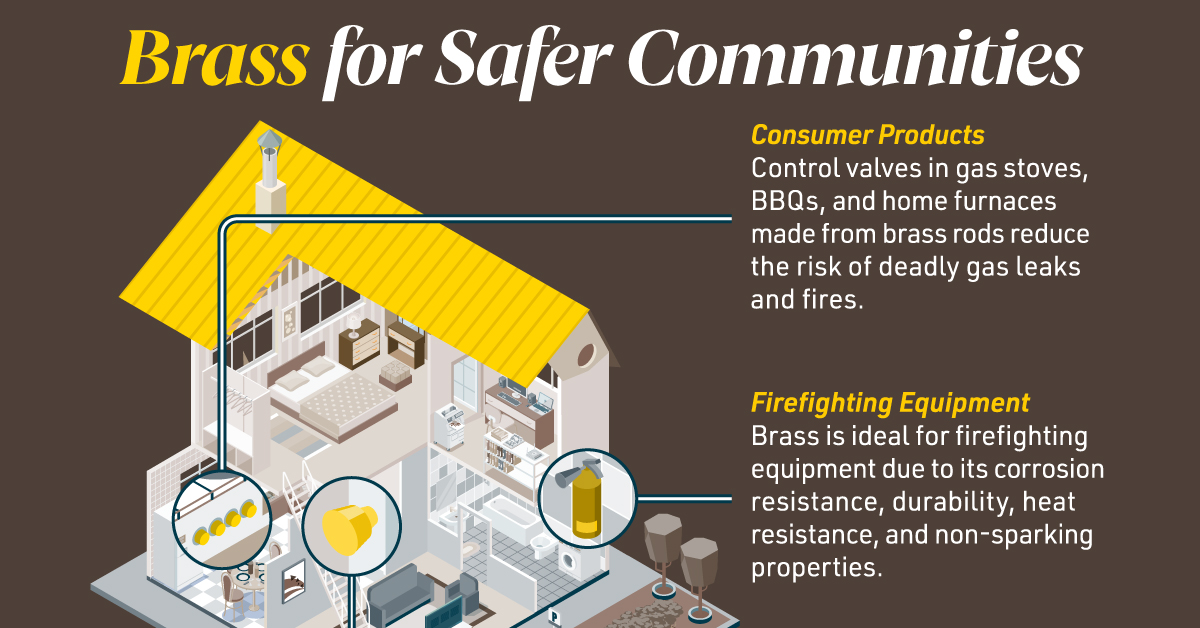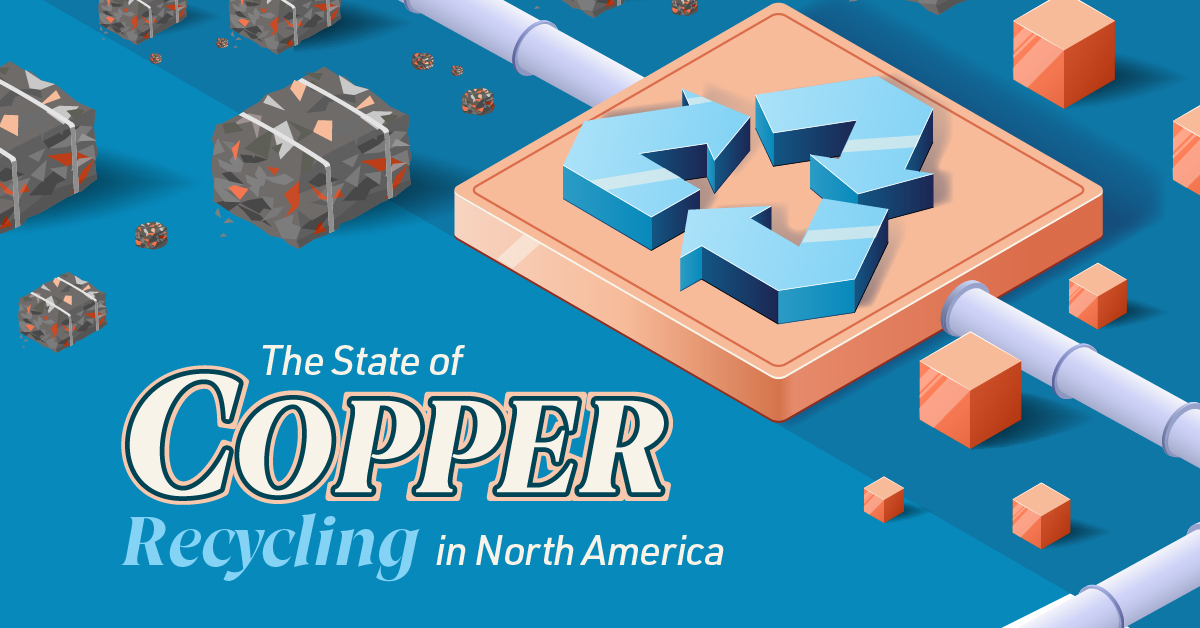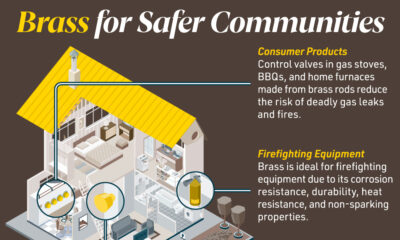Misc
The Largest Copper Mines in the World by Capacity

The Largest Copper Mines in the World
Copper is one of the most-used metals in the world, for good reason.
Global copper production has expanded with populations and economies, especially in China, which consumed 54% of the world’s refined copper in 2020. Copper’s demand comes from various industries, ranging from construction to renewable energy.
But before copper reaches its array of end-uses, miners have to extract and refine from deposits within the ground. So where are the world’s largest copper mines, and just how large are they?
Types of Copper Deposits
The location of mines ultimately depends on the occurrence and discovery of copper deposits. There are two main types of copper deposits:
- Porphyry deposits:
These are copper ore bodies formed from hydrothermal fluids from magma chambers that lie deep below the deposit. - Sediment-hosted deposits:
These deposits are formed when copper-bearing fluids mix with permeable sedimentary and volcanic rocks.
Copper is primarily sourced from porphyry deposits, which are concentrated in the Americas. Therefore, many of the world’s largest copper mines operate in this region.
Top 20 Copper Mines by Capacity
North, South, and Central America collectively host 15 of the 20 largest copper mines. These three regions combine the capacity for nearly 36% of global copper production in 2020.
| Rank | Mine | Country | Annual Production Capacity (tonnes) | Capacity as a % Global Production† |
|---|---|---|---|---|
| 1 | Escondida | Chile 🇨🇱 | 1,400,000 | 7.0% |
| 2 | Collahuasi | Chile 🇨🇱 | 610,000 | 3.1% |
| 3 | Buenavista del Cobre | Mexico 🇲🇽 | 525,000 | 2.6% |
| 4 | Morenci | U.S. 🇺🇸 | 520,000 | 2.6% |
| 5 | Cerro Verde II | Peru 🇵🇪 | 500,000 | 2.5% |
| 6* | Antamina | Peru 🇵🇪 | 450,000 | 2.3% |
| 6* | Polar Division | Russia 🇷🇺 | 450,000 | 2.3% |
| 8 | Las Bambas | Peru 🇵🇪 | 430,000 | 2.2% |
| 9 | Grasberg | Indonesia 🇮🇩 | 400,000 | 2.0% |
| 10 | El Teniente | Chile 🇨🇱 | 399,000 | 2.0% |
| 11* | Chuquicamata | Chile 🇨🇱 | 370,000 | 1.9% |
| 11* | Los Bronces | Chile 🇨🇱 | 370,000 | 1.9% |
| 11* | Los Pelambres | Chile 🇨🇱 | 370,000 | 1.9% |
| 14 | Kansanshi | Zambia 🇿🇲 | 340,000 | 1.7% |
| 15 | Radomiro Tomic | Chile 🇨🇱 | 330,000 | 1.7% |
| 16* | Kamoto | Congo 🇨🇩 | 300,000 | 1.5% |
| 16* | Cobre Panama | Panama 🇵🇦 | 300,000 | 1.5% |
| 18 | Bingham Canyon | U.S. 🇺🇸 | 280,000 | 1.4% |
| 19 | Toquepala | Peru 🇵🇪 | 265,000 | 1.3% |
| 20 | Sentinel | Zambia 🇿🇲 | 260,000 | 1.3% |
*Mines with equal capacities have the same rankings. †2020
The Escondida Mine in Chile is by far the world’s largest copper mine. Its annual capacity of 1.4 million tonnes means that it can produce more copper than the second and third-largest mines combined.
Porphyry copper deposits are often characterized by lower grade ores and are mined in open pits. As a result, some of the top copper mines are also among the world’s largest open pits. The Bingham Canyon Mine (seen below) in Utah, United States, is the deepest open pit with a depth of 1.2 km. It’s also the largest man-made excavation on Earth, spanning 4 km wide.
Chuquicamata and Escondida are the second and third-deepest open pits, respectively.
Indonesia’s Grasberg Mine is another notable name on this list. It produces both gold and copper on a massive scale and has the world’s largest known reserve of gold and the second-largest reserve of copper.
Overall, the top 20 mines have the capacity to produce nearly nine million tonnes of copper annually—representing 44% of global production in 2020. However, with demand for refined copper expected to rise 31% between 2020 and 2030, these existing sources of supply might not be enough.
Falling Grades, Rising Demand: New Mines on the Block?
According to the International Energy Agency, average copper ore grades in Chile have declined by 30% in the last 15 years. Since Chile’s mines produce more than one-fourth of the world’s copper, these falling ore grades could be a cause for concern—especially with a deficit looming over the market for refined copper.
New copper mining projects are becoming more valuable and it wouldn’t be surprising to see fresh names on the list of the largest copper mines. For example, the Kamoa-Kakula Mine, which started production in May 2021, is expected to churn out 800,000 tonnes of copper annually after expansion. That would make it the second-largest copper mine by capacity.
Misc
Brass Rods: The Safe Choice
From airbags to firefighting equipment, components made from brass rods play a vital role in creating a safer environment.

Brass Rods: The Safe Choice
From airbags to firefighting equipment, components made from brass rods play a vital role in creating a safer environment.
This infographic from the Copper Development Association illustrates three use cases for brass. This is the first of three infographics in our Choose Brass series.
Why Brass?
Brass is one of the most reliable metals for industrial and other applications. It contains little to no iron, protecting it from oxidation, which can cause other materials to fail over time.
Additionally, the malleability of brass ensures tight and leak-free metal-to-metal seals for threaded joints, minimizing the risk of costly and dangerous system failures. Brass’s durability ensures critical system components function properly for years.
Brass for Safe Water Systems
Exposure to lead in water can cause various health problems, including neurological damage, developmental delays, and cardiovascular diseases.
As a result, the U.S. sets minimum health-effect requirements for chemical contaminants and impurities indirectly transferred to drinking water from products, components, and materials used in water systems.
Currently, only brass rod alloys are designated as “acceptable materials” according to national standards.
Brass is also essential for ensuring workplace safety, particularly in high-risk manufacturing environments.
Using Brass for Safe Manufacturing and Industrial Environments
Brass is used extensively in industrial applications such as machinery components, valves, fittings, architectural elements, bearings, and gears.
The machinability of brass rods also means longer tool life and higher productivity for manufacturers of precision parts.
The microstructure of brass helps break up metal chips generated during machining operations, preventing long and stringy chips that can crash machines and seriously injure operators.
Additionally, brass’s non-sparking properties make it ideal for tooling, fittings, and components in high-risk industries such as oil & gas, chemicals, pharmaceuticals, paint manufacturing, power plants, and explosives.
Brass for Safer Communities
Many pieces of equipment in our daily lives also rely on brass rod parts to function. Control valves in gas stoves, BBQs, and home furnaces made from brass rods reduce the risk of deadly gas leaks and fires.
Moreover, brass is ideal for firefighting equipment due to its corrosion resistance, durability, heat resistance, and non-sparking properties.
Fittings made from brass rods ensure that the brakes and airbags in our vehicles work when needed.
Brass and other copper-based alloys are also naturally antimicrobial, helping prevent diseases when used in high-touch surfaces such as door handles.
These are only some of the ways that brass rods help build a safer world for everyone.
Explore the Advantages of Brass Rod Solutions.
Misc
The State of Copper Recycling in the U.S.
This graphic explores how recycling copper can help address the demand for the metal in the U.S.

The State of Copper Recycling in the U.S.
Copper is essential for a low-carbon economy due to its crucial role in renewable energy technologies.
As a result, many worry that a lack of the metal used in wires and batteries can hurt a transition to a green economy.
In this graphic, our sponsor, the Copper Development Association, explores how recycling can address the demand for copper.
Copper Scrap Recycled in the U.S.
In 2022, the total copper scrap recycled in the U.S. was approximately 830,000 tonnes, equivalent to 32% of the total U.S. copper supply for the same period. Around 670,000 tonnes (81%) originated from pre-consumer sources generated during manufacturing operations, while 160,000 tonnes (19%) came from post-consumer sources, such as obsolete products.
Brass and wire-rod mills accounted for the majority of the copper recycled from scrap (85%). Additionally, smelters, refiners, and ingot makers make 10% and chemical plants, foundries, and other manufacturers around 5%.
| Copper from Scrap | 2022 Content (tonnes) |
|---|---|
| Brass and wire-rod mills | 650,000 t |
| Smelters and refiners | 40,000 t |
| Ingot makers | 39,500 t |
| Foundries, Other | 40,000 t |
Despite the rising demand for copper, the U.S. predominantly exports its copper scrap.
In 2022, the U.S. exported half of the 1,569,000 tonnes of the copper content generated from scrap. This export trend persisted because, until recent years, the country lacked operating secondary copper smelters capable of processing complex scrap grades into furnace-ready raw materials.
However, reshoring this metal presents an opportunity for the country.
Tapping into the Urban Mine
North America currently has about 86 million tonnes (Mt) of copper in use, known as the Urban Mine. This copper will become available for recycling as aging infrastructure and products reach the end of their service lives:
- Buildings: 45.4 Mt
- Infrastructure: 16.1 Mt
- Consumer Products: 11.2 Mt
- Transport: 8.5 Mt
- Industrial Uses: 4.8 Mt
Increased secondary smelting and refining capacity is a crucial building block for a more resilient and self-sufficient U.S. copper supply chain.
In response to the growing need for copper, the U.S. plans to add over 280,000 tonnes of secondary smelting and refining capacity in the next few years. This expansion will enable the country to process more complex scrap grades domestically.
Given that copper products can last for decades, creating a lag time before the material becomes available for recycling, primary production will continue to play an important role in meeting the increasing needs in the U.S.
The Copper Development Association (CDA) brings the value of copper and its alloys to society to address the challenges of today and tomorrow. Visit www.copper.org to learn more about why copper is a critical mineral.
-

 Electrification3 years ago
Electrification3 years agoRanked: The Top 10 EV Battery Manufacturers
-

 Electrification2 years ago
Electrification2 years agoThe Key Minerals in an EV Battery
-

 Real Assets2 years ago
Real Assets2 years agoThe World’s Top 10 Gold Mining Companies
-

 Misc3 years ago
Misc3 years agoAll the Metals We Mined in One Visualization
-

 Electrification3 years ago
Electrification3 years agoThe Biggest Mining Companies in the World in 2021
-

 Energy Shift2 years ago
Energy Shift2 years agoWhat Are the Five Major Types of Renewable Energy?
-

 Electrification2 years ago
Electrification2 years agoThe World’s Largest Nickel Mining Companies
-

 Electrification2 years ago
Electrification2 years agoMapped: Solar Power by Country in 2021



















